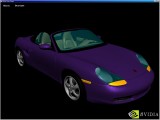 |
|
|
|
In the Forums... |
Posted: October 11, 1999 Written by: Dan "Tweak Monkey" Kennedy Fill Rate Is fill rate really a consideration right now? You may think so, but if you consider that the fill rate of a video card is ultimately limited by your CPU speed, you may reconsider the thought. For the most part, the CPU is the most important item for frame rates... that is, until now. The fill rate of the NVIDIA GeForce 256 is a stunning 480 Million Pixels/Second. This alone is over 50% higher than that of a TNT2 Ultra. But as I said above, the CPU was the main concern. I say WAS the main concern because the GPU now takes the role of the most power consuming 3D functions, which in turn allows the graphics chip to truly take advantage of the incredible fill rate. So before you think, "My Pentium II 300 is too slow for a card with that much speed. I will need to upgrade my CPU," think of the GeForce 256 in terms of CPU independence. Finally, a graphics chip that will take care of the graphics! Higher resolutions, color depths and neat eye candy goodies will be more accessible than ever before. More Features  Click to enlarge Before I head into technical details on how the chip works, you should know what else this chip offers that separates it from the past. As I said before, it offers a fill rate of 480 million pixels/second. Some other goodies:
Note: These images may appear very distorted and banded from compression unless you change the color depth to 32-bit (and with Internet Explorer, restart Windows). The Porsche Boxster demo was unbelieveable. This car is made of around 100,000 triangles and looks real. Even the 1600x1200 image above does little justice to the model. When I was at NVIDIA, I saw the GeForce 256 displaying this car with real time reflections at what appeared to be at least 30 FPS (judging from eye) on an unknown CPU that an engineer claimed to be a Pentium II 400. When I tried running this on my Pentium II 450 / TNT2 Ultra system it crawled at close to 5 FPS. Praise T&L!
This closeup of the wheel lets you see just how much detail you can have with 100,000 triangles. Even the lugnuts and curves look completely real. Imagine how nice a car like this would look in Need For Speed: High Stakes, or any 3D model for that matter (with this much detail) would make a game look. The transform and lighting engines are what most people are interested in, as these will offer incredible visual benefits and performance increases. I will explain more on T&L on the next page. |
||||||||||
|
| |||||||||||
|---|---|---|---|---|---|---|---|---|---|---|---|



